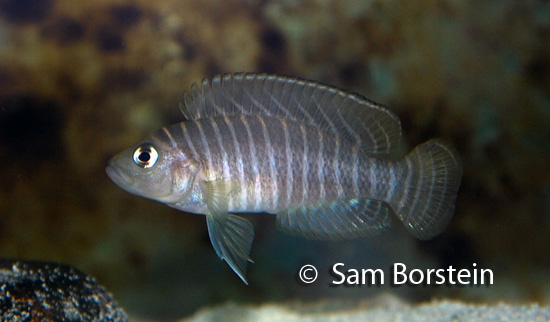'Lamprologus' similis
(Büscher, 1992)
Similis
Synonyms: Neolamprologus similis

Above: A male 'Lamprologus' similis . Photo by Rick Borstein.
Etymology:
Genus- Lampas= Bright (Latin), lagos= hare (Greek)
Species- similis= Similar (Latin). For the similarity in looks between this fish and 'Lamprologus' multifasciatus.
Intro:
'Lamprologus' similis is a tiny shell dweller from Lake Tanganyika. This fish for its size really packs a punch, and are fearless. Over the years, this neat little shellies has become more and more available. They are a pleasure to have in an aquarium, and show magnificent behavior.
This species gets its name from its similarity to 'Lamprologus' multifasciatus. The differences for telling the two apart are as follows (Buscher, 1992):
- 'Lamprologus' similis has a larger eye than 'Lamprologus' multifasciatus.
- 'Lamprologus' similis has one more stripe, located across the head.
Distribution:
'Lamprologus' similis live in empty shells on the sandy bottom of Lake Tanganyika.
Size, Maturity, and Sexual Dimorphism:
Size: Males- 2 inches, Females- 1.75 inches
Maturity: 1.25 inches
Sexual Dimorphism: Males are larger. Females get a rounder abdomen.
Care:
'Lamprologus' similis is extremely aggressive for its size. I had a tank of them and full grown Aulonocara stuartgranti, and the Similis beat the snot out of them to the point that I had to remove the peacocks. I found males really intolerant of each other and my dominant male eventually killed the sub-dominant fish, even in a 20 gallon with multiple shells.A good breeding colony of 1 male and 4-5 females can easily be kept in a 20 gallon. I like to use big liveberers like mollies with my similis, as they are quick and large bodied, and act as both a dither and target fish for the 'Lamprologus' similis, which can be shy.
Diet:
Feeding is a non-issue, as they will accept any flake or small pellet. I only fed mine newly hatched baby brine and had lots of success raising them that way and getting them to breed. Because you never know if they've bred and have fry, I recommend feeding baby brine daily.Breeding:
Similis are very shy when it comes to breeding. This is why the baby brine shrimp is so necessary. I didn't know I had fry until I saw a group of 1/2 inch fish in a pvc pipe I had. This fish can be difficult to breed and is not overly prolific. They have much smaller spawns than Multies.
The parents are excellent at raising the fry and look after them well. Fry grow relatively quickly for a Tanganyikan Lamp.
Conclusion:
This is a great shell dweller. If you want to get into shell dwellers, I still recommend going with the 'Lamprologus' multifasciatus first. If you liked multies or other shellies, give this fish a try.
This is not a fish you are likely to see at a pet shop, but is readily available from hobbyists. They can be expensive.
References:
- Büscher HH (1992a) Ein neuer Cichlide aus dem Tanganjikasee. Neolamprologus similis n. sp. DATZ 45, 520–525
- Konings, A. (1998) Tanganyikan cichlids in their natural habitat. Cichlid Press, El Paso, Texas, 272 pp.
